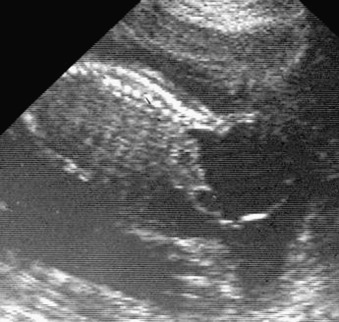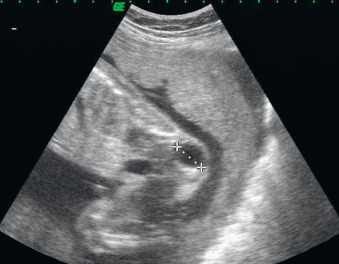Abstract
Sacrococcygeal teratoma (SCT) is the most common tumor in newborns. Predominantly cystic tumors do not compromise intrauterine development, even when the diagnosis is made in the second trimester. The prognosis of cystic tumors is excellent in cases with uneventful gestation, and if the tumor can be removed successfully after delivery. Predominantly solid tumors may lead to cardiac failure and fetal hydrops, and therefore perinatal mortality and morbidity are high because of preterm delivery, anemia, dystocia, and tumor rupture. Magnetic resonance imaging (MRI) is helpful for determining the intrapelvic extent and evaluating the spine and tumor hemorrhage. Prenatal diagnosis is essential for optimal perinatal management.
Keywords
germ cell tumor, sacrococcygeal teratoma, polyhydramnios, fetal surgery
Introduction
Sacrococcygeal teratoma (SCT) is the most common tumor in newborns. Fetal SCT diagnosed in utero is associated with a 50% risk of preterm delivery, a mortality rate of 15% to 35%, and a morbidity rate of 12% to 68%.
Perinatal mortality and morbidity are high because of high-output cardiac failure, fetal hydrops, preterm delivery, anemia, dystocia, and tumor rupture. The intrapelvic and intraabdominal extent of SCT and its compressive effect on the urinary tract also affect perinatal morbidity. The prognosis is excellent in cases with uneventful gestation and if the tumor can be resected entirely and successfully after delivery. Identification of fetuses at risk for perinatal complications is important in order to counsel the parents and to plan perinatal management. The ultrasound (US) morphologic differentiation into predominantly solid and predominantly cystic tumors is an important prognostic factor ( Fig. 31.1 ).

Cystic tumors tend not to compromise intrauterine development even when the diagnosis is made in the second trimester. Predominantly solid tumors may lead to cardiac failure and fetal hydrops. The value of the Surgical Section classification of the American Academy of Pediatrics is that it incorporates the ease of surgical resection, prenatal detection, and the likelihood of malignancy ( Fig. 31.2 ).

Disease
Definition
An SCT is a tumor that develops at the base of the coccyx and is derived from all three germ cell layers. Fetus in fetu (or “inclusion twin”) involves a malformed parasitic monozygotic twin found inside the body of its co-twin, usually in the abdominal cavity or in the sacrococcygeal region.
Prevalence and Epidemiology
The incidence of SCT is 1 : 40,000 live births. Females are four times more commonly affected, but malignancy is more common in males. Malignant elements are generally not seen in fetal SCT. However, because small, predominantly intrapelvic SCT may go undiagnosed for years, until they grow large enough to cause pain, constipation, or other tumor-associated symptoms, the incidence of malignancy within SCT increases with age.
Fetus in fetu is a very rare condition. The overall incidence is 1 : 500,000 live births. The embryopathogenesis and differentiation from teratoma have not been well established.
Embryology
SCTs originate from primitive pluripotent cells at the primitive knot (Hensen’s node) during their migration from the yolk sac to the genital ridge (gestational weeks 4 to 6). These cells normally degenerate and disappear; however, if they escape the control of embryonic inductors and organizers, a teratoma results. Extragonadal teratomas tend to occur in the midline (anterior mediastinum, retroperitoneum, sacrococcygeal region), are composed of mixed dermal elements derived from all three germ layers, and contain neural elements, squamous and intestinal epithelium, skin appendages, teeth, and sometimes calcium. The sacrococcygeal region is the most frequent site.
Etiology and Pathophysiology
Sacrococcygeal Teratoma
The exact etiology of SCT is unknown; most are thought to be sporadic, but some cases are familial with autosomal dominant inheritance. There is no increased occurrence of chromosomal anomalies in fetuses if there are no associated malformations. In 15% of patients, associated congenital anomalies are present, such as imperforate anus, sacral bone defects, duplication of the uterus or vagina, spina bifida, and meningomyelocele.
Most SCTs are benign. If the tumor is resectable after birth, there is no significant morbidity. Perinatal mortality and morbidity are attributed to various mechanisms. The main perinatal risk factor besides prematurity is the morphology and vascularity of the tumor.
Morphologic Classification by Ultrasound
Predominantly Cystic Tumor (Type A).
Cystic tumors (15% of cases) with low vascularity do not compromise intrauterine development even when diagnosis is established in the second trimester. Polyhydramnios is frequent in large cystic tumors, which may be due to direct transudation into the amniotic fluid. Vaginal delivery is possible if the tumor size is smaller than 5 cm. For tumors larger than 5 cm, aspiration of cystic lesions may allow vaginal delivery.
Cystic-Solid Tumors (Type B).
Keslar et al. reported that 71% of 96 SCTs in their series were composed of both solid and cystic elements. Solid tumors with low vascularization of the tumor may not influence fetal well-being, but high blood flow to the tumor typically leads to hemodynamic compromise. In these cases, high-velocity arterial flow signals can be found within the tumor. The tumor acts as a large arteriovenous shunt. The increased blood flow results in high-output cardiac failure with cardiomegaly, pericardial effusions, dilated inferior vena cava, and increased preload indices of the fetal venous system. Reversal of diastolic flow in the umbilical arteries can be observed as the lower resistance in the tumor “steals” blood flow from the placenta. Severe anemia may result from hemorrhage into the tumor; anemia can be diagnosed by demonstrating increased peak blood flow velocity in the middle cerebral artery. Placentomegaly and polyhydramnios relate to the size and vascularization of the tumor. Tumor rupture may be caused by uncontrolled labor or delivery complications. Cesarean section is recommended if the tumor size is larger than 5 cm.
Solid Tumor With Fetal Hydrops (Type C).
Perinatal mortality and morbidity are high in fetuses with hydrops. In fetal hydrops, there is high-output heart failure, which is associated with a dismal prognosis. Hydrops and tumor hemorrhage are associated with the highest risk of fetal death. For this small subgroup, fetal therapy with surgical removal of the teratoma in a previable fetus may prove to be the most effective treatment, but this approach is still investigational. Severe cases may also lead to maternal “mirror syndrome”, manifesting as severe preeclampsia. In fetuses with solid, highly vascularized SCT, percutaneous radiofrequency ablation of the feeding tumor vessels may diminish blood flow sufficiently to reverse high-output fetal heart failure.
The individual risk can be established with US morphologic classification and other fetal and tumor characteristics ( Table 31.1 ).
| Low Risk | Intermediate Risk | High Risk | |
|---|---|---|---|
| US morphology | Type A (cystic) | Type B (cystic-solid) | Type C (solid with fetal hydrops) |
| Tumor size | <5 cm | 5–10 cm | >10 cm |
| Associated malformations | No | Renal pyelectasis | Chromosomal anomalies, spina bifida |
| Gestational age at delivery | >32 weeks | 28–32 weeks | <28 weeks |
| Cardiovascular examination | Normal | Myocardial hypertrophy | Impairment of myocardial function; abnormal venous Doppler |
Surgical Classification.
The American Academy of Pediatrics Surgical Section classification scores the extent of SCT for postnatal surgical management ( Table 31.2 ). The tumor also can be graded histologically ( Table 31.3 ), but grading of SCT does not seem to correlate with prognosis.
| Type | |
|---|---|
| I | Predominantly external with minimal presacral component |
| II | External but with significant intrapelvic extension |
| III | External but with a predominantly pelvic mass extending into the abdomen |
| IV | Presacral with no external presentation |
Stay updated, free articles. Join our Telegram channel

Full access? Get Clinical Tree







